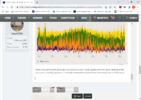- Joined
- 3 July 2009
- Posts
- 27,866
- Reactions
- 24,925
Sounds like a World first @Smurf1976 might be able to expand on the article.

 www.smh.com.au
www.smh.com.au
South Australia breaks record by running for a week on renewable energy
Analysts believe South Australia’s more than six-day run on green energy may be a global first for a power grid supporting an advanced economy.



